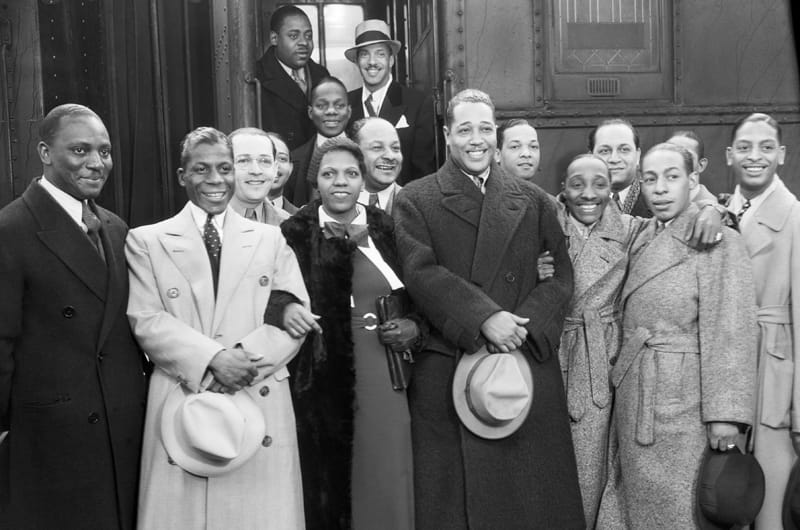How Jazz Influenced Fashion: New Book to Launch During Jazz Appreciation Month in April

- Drexel Environmental Collaboratory Releases Cross-Sector Findings on Severe Weather Recovery Challenges
- Student Sketches Bring Drexel’s Historic Objects to Life
- Drexel’s Hydration Stations Cut Plastic Waste and Costs
- Drexel Launches the Manuel Stamatakis Center for Alternative Investments at the LeBow College of Business

From Duke Ellington’s houndstooth blazer to Billie Holiday’s signature gardenias, jazz musicians and singers throughout history have used fashion to challenge stereotypes of race, class and gender.
Born in the late 19th century, jazz gained mainstream popularity during a volatile period of racial segregation and gender inequality. It was in these adverse conditions that jazz performers discovered the power of dress as a visual tool used to defy mainstream societal constructs, shaping a new fashion and style aesthetic.
A new book by Alphonso D. McClendon, an assistant professor in Drexel University's Antoinette Westphal College of Media Arts & Design, entitled Fashion and Jazz: Dress, Identity and Subcultural Improvisation (Bloomsbury Publishing, 2015), explores the behaviors, signs and meanings that defined this subculture. The book also addresses Philadelphia’s significant role in jazz history.
At a book launch event on Monday, April 20 at 6 p.m. and in celebration of Jazz Appreciation Month, McClendon will discuss and sign copies of the book. The event is free and open to the public, and will take place in URBN Center Room 349 (3501 Market Street). The book is available for purchase from the publisher and from Amazon.com.
“This book demonstrates how two connected art forms exemplify freedom of expression, improvisational showmanship, pursuits of modernity and cultural transformation in America and globally,” said McClendon. “Without jazz – its architects, struggles for equality and the multicultural roots and style of the music – contemporary society would be less connected.”
Drawing on fashion studies and cultural theory, the book provides an in-depth analysis of the social and political entanglements of jazz and dress. Including a wide variety of case studies, ranging from Billie Holiday and Ella Fitzgerald to Louis Armstrong and Chet Baker, it presents a critical and cultural analysis of jazz performers as modern icons of fashion and popular style.
Addressing a number of previously underexplored areas of jazz culture, such as modern dandyism and the link between drug use and glamorous dress, Fashion and Jazz provides a fascinating history of fashion's dialogue with African-American art and style.
“I’m seeing some of the same themes appear in the 21st century that I traced in the book,” said McClendon. “For example, the disruption of established aesthetics, the subversive representation of popular music and dress, the eccentric and elite manner of performers, traits of fashionable addiction and strivings for equality continue to be fastened to new forms of music and contemporary artists. This book is a guide for that discourse.”
McClendon’s research was conducted at the Institute of Jazz Studies at Rutgers University, the Schomburg Center for Research in Black Culture, the Archives Center at the National Museum of American History, the Hogan Jazz Archive at Tulane University, the Fontanes Private Collection in Biarritz and the Free Library of Philadelphia.
From April to June, McClendon will exhibit photography from the book by renowned jazz photographer and musician Charles Peterson, courtesy of Don Peterson. Peterson’s subjects include Billie Holiday, Lester Young, Fats Waller and other jazz greats in studio, at jam sessions and on the streets of New York City. The photography can be viewed in the Charles Evans Library Exhibition Window on the third floor of the URBN Center.
About Alphonso McClendon
McClendon investigates the visual and behavioral representations of jazz and African American aesthetics that influence fashion, media and popular culture. McClendon authored “Fashionable Addiction,” a book chapter on the influence of the heroin chic aesthetic, in Fashion in Popular Culture: Literature, Media and Contemporary Studies (Intellect, 2013), as well as articles on jazz era prohibition, male dress conformity and defiance and the history and culture of the U.S. drug policy.
McClendon came to Drexel with 15 years of corporate experience as a fashion designer, product development manager and accountant, having worked with companies such as VF Corp., Nautica, Phillips-Van Heusen, Izod and 3M. He teaches courses in fashion business practice and entrepreneurship, digital and manual patternmaking, technical design, CAD textile design and digital portfolio development. McClendon’s industry experience with design and production professionals in China, Taiwan and Japan informs his academic engagement. He is the fashion group’s area chair for the Popular Culture/American Culture Associations (PCA/ACA) and serves on the editorial board of the Journal of Design, Business & Society (Intellect).
Drexel News is produced by
University Marketing and Communications.